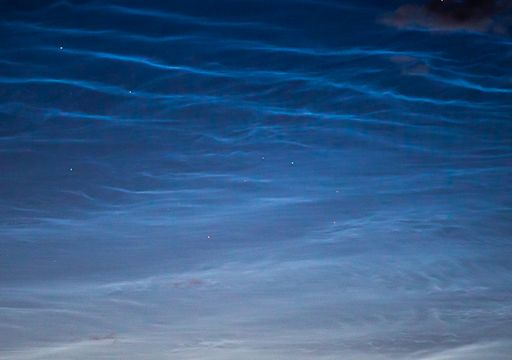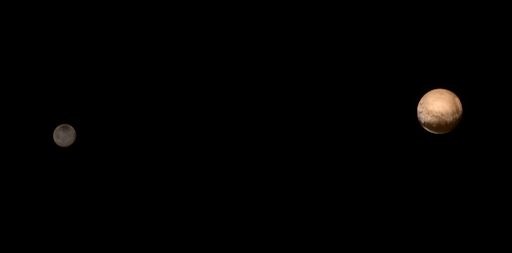Come to Tromsø and share Marianne's passion for rural photography: Chasethelighttours.co.uk invites you to experience "Heaven on Earth" with an aurora, fjord, fishing, whale watching, photography or sightseeing tour. | | |
GEOMAGNETIC STORM: As predicted, a G1-class geomagnetic storm has broken out during the late hours of July 10th. The cause of the storm is an unsettled stream of solar wind, which is buffeting Earth's magnetic field now. High-latitude sky watchers should be alert for auroras, especially during the hours around local midnight. Aurora alerts: text or voice.
NOCTILUCENT CLOUDS OVER EUROPE: High above Europe, Earth's upper atmosphere has been very active this week. First, observers saw red sprites dancing across the tops of thunderstorms. And now a bright display of electric-blue noctilucent clouds (NLCs) is underway. Rayann Elzein sends this picture, taken just after nightfall on July 10th, from Nijmegen, The Netherlands:

"This was my second evening this week seeing NLCs in the Dutch sky!" says Elzein. "And tonight the clouds were infinitely brighter than earlier in the week. They also presented many more shapes and lasted longer." Similar reports are coming in from Denmark, Sweden, Germany, and Slovakia.
NLCs are Earth's highest clouds. Seeded by meteoroids, they float at the edge of space more than 80 km above the planet's surface. The clouds are very cold and filled with tiny ice crystals. When sunbeams hit those crystals, they glow electric-blue.
Noctilucent clouds first appeared in the 19th century after the eruption of super-volcano Krakatoa. At the time, people thought NLCs were caused by the eruption, but long after Krakatoa's ash settled, the clouds remained. In recent years, NLCs have intensified and spread with summer sightings as far south as Utah and Colorado. This could be a sign of increasing greenhouse gases in Earth's atmosphere.
Observing tips: Look west 30 to 60 minutes after sunset when the Sun has dipped 6o to 16o below the horizon. If you see luminous blue-white tendrils spreading across the sky, you may have spotted a noctilucent cloud.
Realtime NLC Photo Gallery
PLUTO IS NOT ALONE: New Horizons is now less than 3 days from Pluto. For years, the "dwarf" planet has been little more than a fuzzy blob in the eyepieces of distant telescopes. Not even the Hubble Space Telescope could see it clearly. Those days are over. On July 7th, New Horizons snapped this image of Pluto and its biggest moon Charon from a distance of only 5 million miles:

Neither Pluto nor Charon is a "fuzzy blob." Moreover, the crisp images reveal many interesting differences: The reddish materials that color Pluto seem to be completely absent on Charon. On Charon, only a dark polar region interrupts the light gray terrain.
"These two objects have been together for billions of years, in the same orbit, but they are totally different," says Alan Stern of the Southwest Research Institute (SwRI) in Boulder, Colorado. Stern is the principal investigator for the New Horizons mission.
Charon is about 750 miles (1200 kilometers) across, about half the diameter of Pluto—making it the solar system's largest moon relative to its planet. "Charon is now emerging as its own world," adds John Spencer, another member of the science team at the SwRI. "Its personality is beginning to really reveal itself."
On July 14th, when New Horizons makes its closest approach to the Pluto-Charon system, the images it beams back will have 500 times better resolution than we see today. Stay tuned!
Realtime Pluto Photo Gallery
Realtime Sprite Photo Gallery
Realtime Space Weather Photo Gallery
Realtime Aurora Photo Gallery
Every night, a network of NASA all-sky cameras scans the skies above the United States for meteoritic fireballs. Automated software maintained by NASA's Meteoroid Environment Office calculates their orbits, velocity, penetration depth in Earth's atmosphere and many other characteristics. Daily results are presented here on Spaceweather.com.
On Jul. 10, 2015, the network reported 7 fireballs.
(6 sporadics, 1 beta Camelopardalid)

In this diagram of the inner solar system, all of the fireball orbits intersect at a single point--Earth. The orbits are color-coded by velocity, from slow (red) to fast (blue). [Larger image] [movies]
Potentially Hazardous Asteroids (
PHAs) are space rocks larger than approximately 100m that can come closer to Earth than 0.05 AU. None of the known PHAs is on a collision course with our planet, although astronomers are finding
new ones all the time.
On July 10, 2015 there were potentially hazardous asteroids.
Notes: LD means "Lunar Distance." 1 LD = 384,401 km, the distance between Earth and the Moon. 1 LD also equals 0.00256 AU. MAG is the visual magnitude of the asteroid on the date of closest approach. | | The official U.S. government space weather bureau |
| | The first place to look for information about sundogs, pillars, rainbows and related phenomena. |
| | Researchers call it a "Hubble for the sun." SDO is the most advanced solar observatory ever. |
| | 3D views of the sun from NASA's Solar and Terrestrial Relations Observatory |
| | Realtime and archival images of the Sun from SOHO. |
| | from the NOAA Space Environment Center |
| | the underlying science of space weather |
| | Web-based high school science course with free enrollment |

